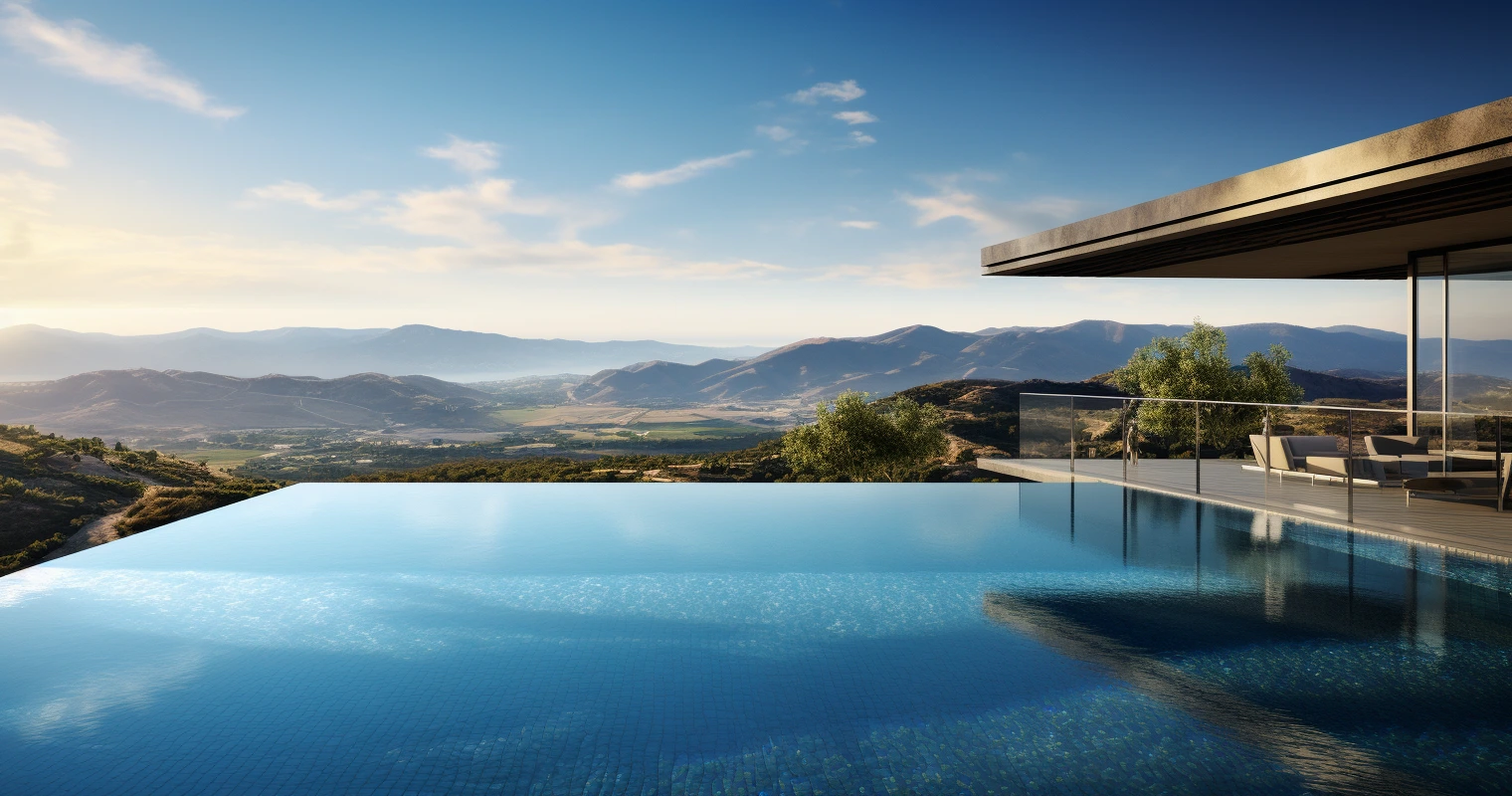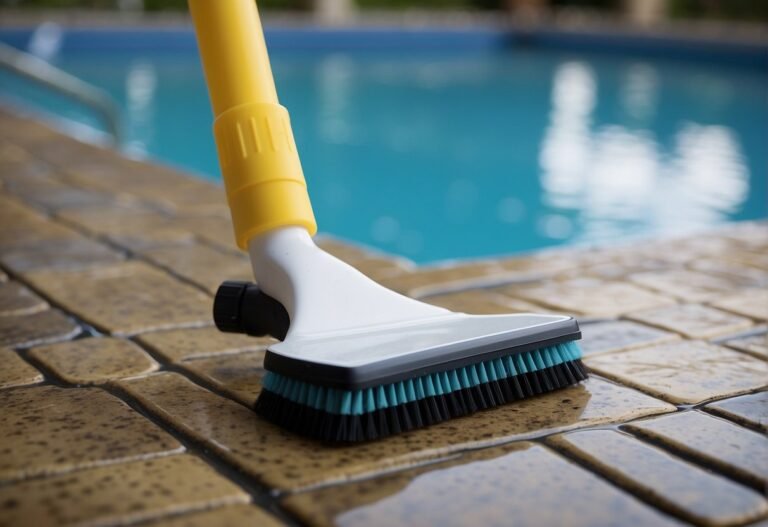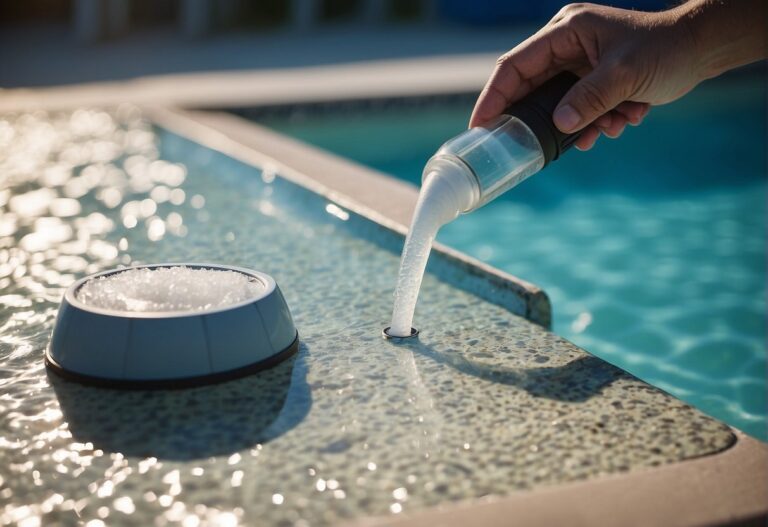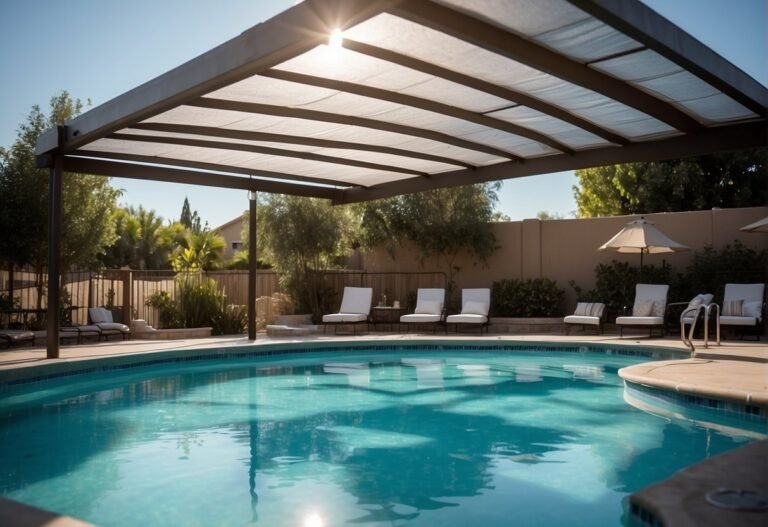Glass pools are the new cool wave in swimming fun, giving your swim a slick, fancy twist that’s catching eyes all over. I’m totally into this fancy splash zone because it’s not only drop-dead gorgeous, but it’s also strong as a tank. Thanks to some wizard-level science and tough-as-nails glass, these beauties let you have a swim show like no other, making any space look like something out of a magazine.
These pools often feature glass walls or floors, creating an illusion of depth and openness while allowing natural light to penetrate the water. This results in a serene and captivating swimming environment that’s perfect for us to relax and enjoy. Furthermore, the use of glass provides an unobstructed view into the pool, bringing swimmers closer to nature and offering a whole new swimming dynamic.
Key Takeaways
- Glass swimming pools provide a unique and visually stunning aquatic experience
- Specialized engineering and materials allow for durable and safe glass structures
- These pools often integrate natural light and unobstructed views, enhancing the overall swimming experience
Understanding Glass Swimming Pools
Glass swimming pools, often referred to as “transparent” or “infinity” pools, are an innovative and luxurious addition to residential and commercial properties. These cutting-edge pools incorporate high-quality glass materials in their design, allowing for a visually stunning experience for swimmers and viewers alike.
When designing a glass swimming pool, choosing the appropriate glass material plays a crucial role in the final outcome. The glass used in these pools often consists of heat-strengthened laminated glass, which is shatterproof and provides added safety when subjected to impact forces.
One of the primary benefits of incorporating glass into swimming pool design is the seamless connection between the indoor and outdoor spaces. This not only enhances the visual appeal but also provides a sense of openness and integration with nature.
There are various types of glass available for swimming pool glazing, each offering different levels of strength, durability, and aesthetics. It is important to choose a glass type that best suits your needs and ensures the longevity of your swimming pool.
To achieve the desired effect and functionality, special attention should be given to other design elements such as interlayer types, support detailing, and appropriate glass thickness. These factors not only improve the performance and safety of your glass swimming pool but also contribute to its longevity and durability.
Understanding the complexities of glass swimming pools is essential for creating a visually stunning and structurally sound addition to your property. By considering the glass materials, connection details, and aesthetics, you can ensure that your swimming pool is both a functional and beautiful space to enjoy.
Features of Glass Swimming Pools

Transparency
One of the key features of a glass swimming pool is its transparency. This creates a stunning visual effect, as the pool seems to glow in the dark thanks to the underwater lights. A glass wall without top reinforcement can achieve an elegant, seamless appearance. This transparency also helps connect an indoor swimming pool with the outdoors, merging the division between pool and outdoor areas.
Safety Measures
Glass swimming pools prioritize safety by utilizing laminated glass. This type of glass is made by combining two or more glass panes with a resinous adhesive interlayer. This multi-pane glass and adhesive interlayer ensure maximum strength and shatterproof behavior when subjected to impact. The use of laminated glass offers a safe and secure option for your swimming pool construction.
Endurance and Durability
Glass swimming pools are built to stand the test of time, with endurance and durability being top of mind. The structural glass used for swimming pools is typically heat-strengthened and laminated, providing both water tightness and impressive strength. This ensures that your glass pool will not only be safe but also long-lasting and able to withstand the elements. With proper care and maintenance, your glass swimming pool will remain an eye-catching feature of your property for years to come.
Types of Glass Swimming Pools
When you’re considering a glass swimming pool, it’s essential to understand the different types of glass options available. In this section, we will discuss some popular choices for glass swimming pools, which will help you make an informed decision.

The most common and recommended glass for swimming pool glazing is laminated glass. This type of glass is constructed by sandwiching a Polyvinyl Butyral (PVB) layer between two sheets of glass. The PVB layer adds strength to the glass, making it more resistant to impacts and shattering. Additionally, it provides a barrier against moisture and UV rays, essential factors for any pool construction.
Another option for swimming pool glass is structural glass, which offers excellent stability and strength. This glass type is often used for frameless pool enclosures and pool windows. Structural glass has the benefit of providing clear, unobstructed views, enhancing the overall aesthetic of your swimming pool.
For a more unique and stylish look, you can opt for colored or tinted glass. This type of glass can add a striking visual element to your swimming pool area and can help control the amount of sunlight that enters the space. Tinted glass options range from subtle shades to more vibrant, eye-catching colors.
In addition to the glass types mentioned above, you may also want to consider various glass treatments and coatings for your pool. These may include low-maintenance coatings, which help prevent the build-up of dirt and algae, or anti-reflective coatings, which reduce glare and improve the clarity of the glass.
Overall, it’s crucial to consider the specific needs and preferences you have for your glass swimming pool before selecting the appropriate glass type. Each option offers its benefits and unique features, so ensure you choose the one that best suits your vision and requirements.
Design
In addition to the glass types, a selection must also be made with regard to the design. Depending on the installation location, there are various options for the visual design. For inspiration, we have compiled over 16 different glass swimming pool designs.
Installation Process
Site Preparation
Before installing a fiberglass swimming pool, it’s crucial to properly prepare the site. Begin by discussing the pool’s placement, dimensions, and any landscaping considerations with a professional. The installer will be provided with a dig sheet containing precise measurements, ensuring the correct hole size and shape for the pool model. Also, make sure to obtain any necessary permits for excavation and installation.
During site preparation, be careful not to over-excavate. If the hole is dug too deep, avoid placing soil back in the hole, as this may cause settling issues later on. Instead, consult with the installer on the best solution to ensure the pool remains level and secure.
Installation Methodology
After the site is prepared, the actual installation process can begin. Here are the key steps involved in installing a fiberglass swimming pool:
- Pool Shell Preparation: Quality check the pool shell and trim any excess fiberglass for a perfect fit.
- Placement: Use a crane or other heavy equipment to carefully lower the pool shell into the excavated hole, ensuring proper alignment.
- Leveling: Ensure the pool is level before backfilling to avoid uneven pressure, which can cause damage in the long term.
- Backfilling: Fill the gap between the pool shell and the excavation with appropriate backfill material, typically crushed stone, as recommended by the pool manufacturer.
- Plumbing: Install all necessary plumbing, including skimmers, return lines, filter equipment, and any features like a spa or waterfall.
- Electrical: Complete all electrical work, including pool lights and any other accessories.
- Deck and Coping: Build the pool deck and install coping, choosing from a range of materials to match the style and look of your desired pool surround.
By following these steps, your fiberglass swimming pool will be installed safely and efficiently, allowing you to enjoy a beautiful and functional addition to your outdoor space.
Remember, always work with a professional pool installer and adhere to local regulations and safety guidelines to ensure a successful pool installation.
Maintenance and Care
Maintaining and caring for your glass swimming pool involves several key tasks that will keep your pool looking great and functioning optimally. The following sub-sections highlight essential maintenance aspects, including routine cleaning and repairs or replacements when necessary.
Routine Cleaning
Regular cleaning is essential for the longevity and appearance of your glass swimming pool. It’s important to:
- Brush away debris: Use a soft pool brush to gently remove any dirt, algae, or debris from the glass surfaces. Do this at least once a week to prevent buildup.
- Skim the surface: Use a pool skimmer to clear away any floating debris, such as leaves, on the water’s surface daily to ensure that your pool remains clean and inviting.
- Check water chemistry: Test your pool water at least 1-2 times per week to maintain proper pH levels and sanitizer balance. Doing so will not only protect the glass surfaces but also ensure a safe swimming environment. You can find more information on maintaining water chemistry.
- Vacuum the pool: Vacuum your pool weekly or use an automatic pool cleaner specifically designed for glass pools to remove any dirt or sediment that may have settled on the glass surfaces.
Repair and Replacement
Over time, your glass swimming pool may require repairs or replacements to maintain its functionality and appearance. Be mindful of the following:
- Inspect for damage: Regularly inspect the glass surfaces for cracks, chips, or other signs of damage. Promptly address any issues to prevent further damage and ensure the structural integrity of the pool.
- Replace broken glass tiles: If you find any damaged glass tiles, consult with a professional to replace them as soon as possible. Do not attempt to fix cracked or chipped glass tiles on your own, as this could lead to additional damage.
- Consider resealing: Glass pool tiles typically have a protective sealant applied to their surface. Over time, this sealant may wear away, reducing the tiles’ durability and resistance to stains. Consider reapplying a high-quality sealant to your glass tiles to extend their lifespan and maintain their appearance.
By following these maintenance steps and promptly addressing any repair or replacement needs, you’ll ensure your glass swimming pool remains in excellent condition for years to come.
Cost Factors
When considering a glass swimming pool, various cost factors come into play. We’ll examine three main aspects that contribute to the overall cost: material cost, construction cost, and maintenance cost.

Material Cost
The material cost includes the price of the glass panels, framing, and other necessary materials like sealants and hardware. High-quality glass panels can be expensive, but they offer improved strength, safety, and durability compared to cheaper options. Moreover, the thickness of the glass, finish, and any extra features (e.g., solar control or self-cleaning coatings) also impact the material cost. Always consult with a reputable supplier to choose the best type of glass for your swimming pool that suits your budget.
Construction Cost
The construction cost factors in the labor required to build the glass swimming pool, including excavation, installation of the glass panels, finishing, and any additional work, such as lighting or landscaping features. This cost can vary greatly depending on the size and complexity of the project, as well as your geographical location. Keep in mind that obtaining permits and adhering to local building codes may add to the overall construction cost. To minimize this expense, obtaining multiple quotes from qualified contractors and thoroughly comparing their offers is advisable.
Maintenance Cost
Owning a glass swimming pool comes with ongoing maintenance expenses, such as regular cleaning, water treatment, and periodic inspections to ensure the safety of the pool. Additionally, the cost of running equipment like pool pumps and filters can add up over time. Taking into account energy-efficient options and following recommended maintenance schedules will help in reducing these costs and maintaining the pristine condition of your glass swimming pool.
Environmental Impact
When considering a glass swimming pool, it’s essential to be aware of the environmental impact associated with this choice. Glass swimming pools can offer some benefits in terms of sustainability, but they also have potential disadvantages that you should take into account.
One positive aspect of glass swimming pools is their ability to harness natural light. The transparent nature of glass allows sunlight to penetrate the water, which can reduce energy consumption for heating and lighting the pool area. Additionally, using high-quality, energy-efficient glass can help minimize heat loss and contribute to overall energy savings.
The production of glass itself can have a significant environmental impact. The manufacturing process requires large amounts of energy and resources, which adds to your pool’s carbon footprint. To minimize this, choose glass materials that come from recycled sources or look for suppliers that implement sustainable manufacturing practices.
Another concern with glass swimming pools is water usage. Maintaining any pool requires water refilling, treatment, and circulation. To lessen the impact on water resources, equip your pool with efficient plumbing systems and use a pool cover whenever it’s not in use. This helps reduce evaporation and limits the need for extensive refilling.
Lastly, the chemicals used for pool maintenance can have adverse effects on the environment. Using eco-friendly chemicals and implementing proper filtration systems can help alleviate this issue. Furthermore, consider adopting a natural or saltwater pool system to minimize your reliance on harsh chemicals.
In summary, when planning your glass swimming pool, be mindful of the environmental impact and strive to make sustainable choices. Opt for energy-efficient materials, minimize water usage, and choose eco-friendly pool maintenance options.
Our Thoughts about a Pool made of Glass

Building a glass swimming pool can be an attractive addition to your property. They have gained popularity in recent years due to their aesthetic appeal and the unique experience they offer. However, you have to bear in mind the material, construction process, and maintenance requirements before making a decision.
While glass is a stunning material that is easy to make and scratch-resistant, it has certain disadvantages when used in swimming pools. For example, glass may not be the best choice for underwater windows, as it may require constant maintenance and can be harder to repair compared to acrylic alternatives.
Moreover, the structural design of glass swimming pools requires careful consideration. The pool construction, including the foundation, sides, and hardware supporting the glass, must be properly dimensioned based on the material resistance and piece measurements. Therefore, you should ensure that the design and construction processes are carried out by experienced professionals.
Lastly, remember that maintaining your glass swimming pool’s beauty and safety is crucial. Since glass is a more rigid material than acrylic, it may be more prone to damage, which might require expensive repairs or replacement. Opting for acrylic panels instead of glass could be a more cost-effective solution, as they are easier to repair and more resistant to the pool’s water pressure.
In summary, having a glass swimming pool can be an impressive addition to your property, but it requires careful planning and consideration of material choices and maintenance demands. By taking these factors into account, you can achieve an extraordinary and functional swimming pool that meets your needs and preferences.
If you liked this blog post about glass swimming pools take a look into our blog post about wood swimming pools or dive into the newest post about redneck swimming pools and don’t forget to leave us a comment down below to tell us about your experience with it.
Frequently Asked Questions
What is the installation process for swimming pool glass walls?
To install glass pool walls, consult a pro to check pool’s structure, measure, cut, and install panels with stainless steel fittings to withstand water pressure and weather. Follow local codes and safety rules.
How do you construct a glass pool wall?
Constructing a glass pool wall requires selecting glass type such as tempered or laminated glass, cutting panels to fit, installing support brackets, and using seals for water-tightness. Follow safety regulations and building codes.
What are the specifications for swimming pool glass?
Choose pool glass with 12mm to 19mm thickness for strength and durability. Consider pool size and requirements for variations. Select tempered or laminated glass resistant to chemicals and capable of withstanding water pressure, temperature changes, and impacts.
Is laminated glass suitable for swimming pools?
Laminated glass is ideal for pools, offering safety and durability. It’s made of layers of glass with a plastic interlayer, enhancing strength and impact resistance. If it breaks, the plastic layer holds shards, reducing injury risk. Perfect for safety-focused pool use.
How much does an above-ground glass pool cost?
Above-ground glass pool costs vary with size, design, and materials. Pool glass covers average $30 to $75 per sq. ft., excluding installation, equipment, and accessories. Costs can range from affordable to expensive based on chosen features and customizations.
Which is better for swimming pools: glass or acrylic?
Glass offers clarity, strength, and chemical resistance but can be heavier and costlier for a luxurious look. Acrylic is lighter, easier to install, and less prone to breakage but prone to scratches and wear. The choice depends on budget, aesthetics, and maintenance needs.
If you liked this blog post about glass swimming pools, don’t forget to leave us a comment down below to tell us about your experience with it.






